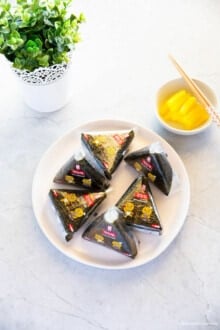Ready for a savory sushi roll? Try these bacon avocado cucumber sushi rolls! It’s super delicious!
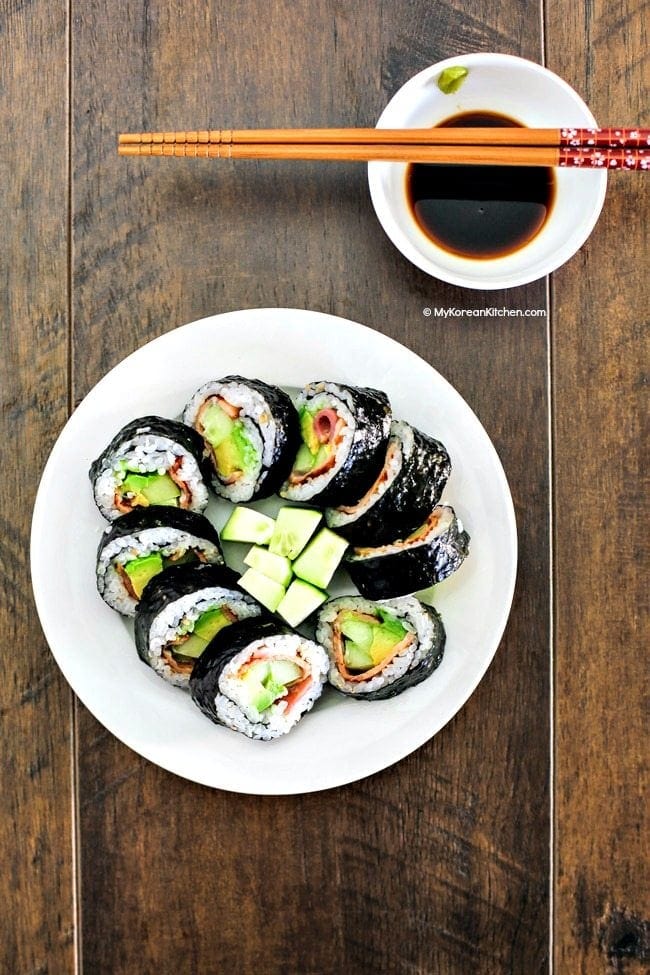
The other day I had a huge craving for Kimbap / Gimbap (김밥, Korean rice rolls) but I didn’t have any Kimbap ingredients in my fridge, so I decided to make with what I had – these bacon avocado cucumber sushi rolls! In a way, I’m glad that I didn’t have all that Korean ingredients because I discovered our family’s new favourite!
My daughter for one, she’s a sushi killer! She’s loved sushi rolls since she was able to have solid food. Every time we ask her what she wants for her lunch during our shopping at the mall, she says sushi rolls! You get the picture right? And my husband and I love these rolls too.
Why We Love Bacon Avocado Cucumber Sushi Rolls
- All the ingredients are available at a local (non-Asian) grocery store. That saves my return trip – 1 hour – to my closest Korean grocery store.
- It’s very delicious and more straightforward to make than a traditional Kimbap as this uses less ingredients.
- Its savory and refreshing at the same time. Mayonnaise is quite important making these sushi rolls savory, so I hope you don’t skip it!
- The crunchy texture from the sesame seeds and cucumber is quite irresistible!
- It goes well in a lunchbox even though it has bacon in it. This is a definitely a big bonus point as my hubby carries a lunchbox to work. If we’re having it the next day, we just leave it out at room temperature 30 mins to 1 hour before consumption to soften up the rice. We don’t microwave this as the seaweed can get soggy.
I hope these are good enough reasons to make for you as well! Enjoy!
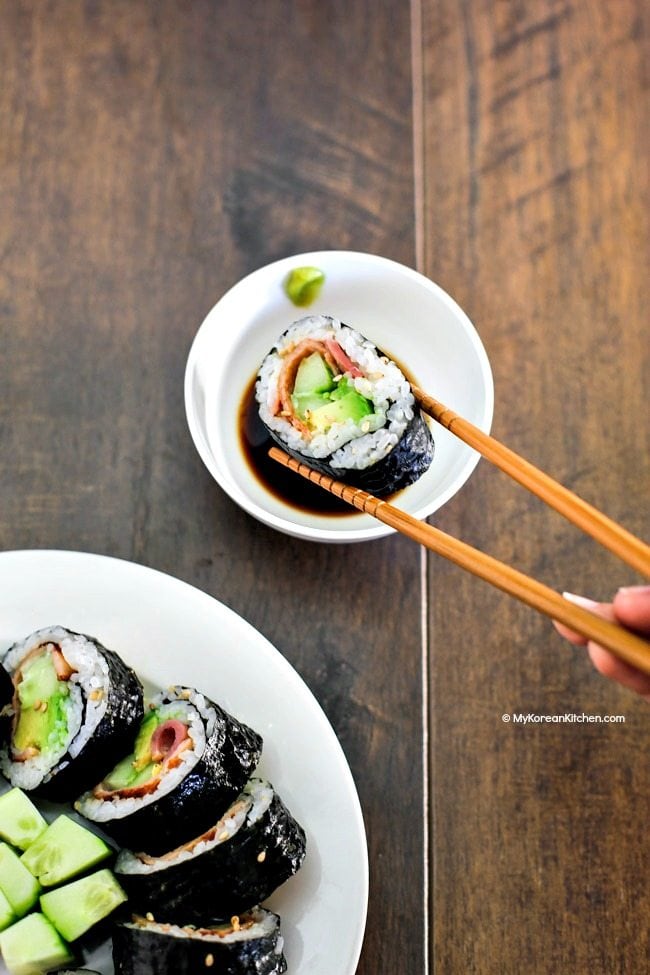
Ingredients for Cucumber Sushi Rolls (Make 7 Rolls)
Main
- 5 and 1/2 cup steamed sushi rice (short grain rice)
- 1 Tbsp roasted sesame seeds
- 7 Sushi seaweed sheets
- 14 rindless short cut bacon rashers, cooked until well done (not too crispy)
- Mayonnaise in a squeezable bottle (I used Japanese Kewpie mayonnaise)
- 1 Avocado (I used hass avocado), pitted, peeled and sliced
- 1 Cucumber (I used English cucumber), peeled and sliced into thin strips
- (Optional) 1 Tbsp sesame oil – to give some Korean flavour and/or to give a shiny look to the rolls
Sushi seasoning (Mix these in a small bowl and microwave it for about 30 seconds to dissolve the sugar. Alternatively you could use 3 Tbsp of pre-made sushi seasoning sauce)
- 3 Tbsp rice vinegar
- 2 Tbsp white sugar
- 1 tsp fine sea salt
Serve with
- A dab of wasabi sauce
- A dash of soy sauce
*1 Tbsp = 15ml, 1 cup = 250ml
How To Make Bacon Avocado Cucumber Sushi Rolls
1. In a large bowl, mix the cooked sushi rice with the sushi seasoning and roasted sesame seeds. Set aside while other ingredients are being prepared as mentioned in the ingredients section.
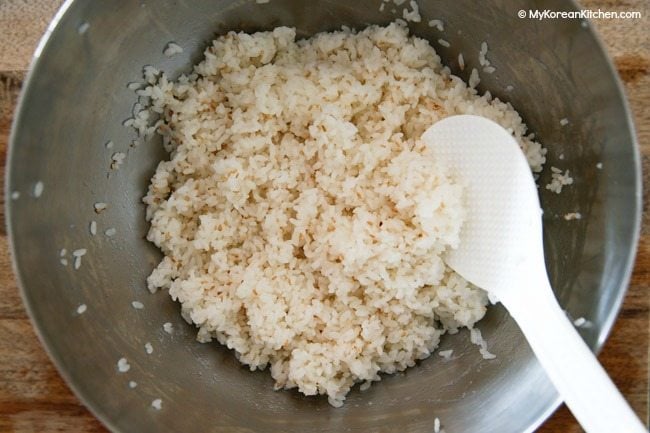
2. Place one seaweed sheet on a bamboo (sushi) mat and thinly spread the rice on the seaweed sheet. (I covered about 90% of the sheet)
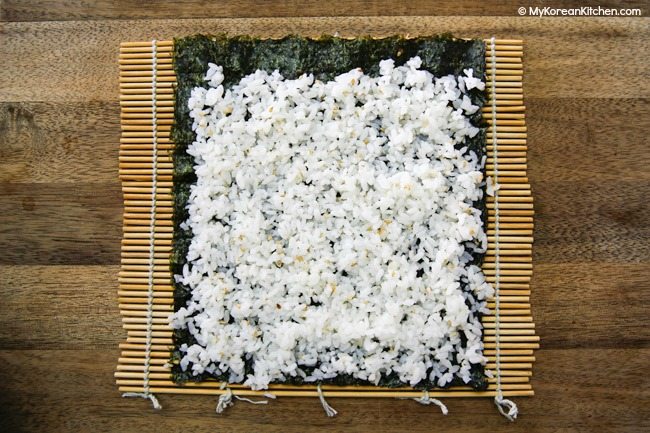
3. Place the prepared ingredients on top of the rice (in the lower centre of the rice) in the order of bacon, mayonnaise (3 to 4 rows), avocado and cucumber strips. (I used 2 short cut bacon, 2 avocado strips and 2 cucumber strips per one sushi rolls).
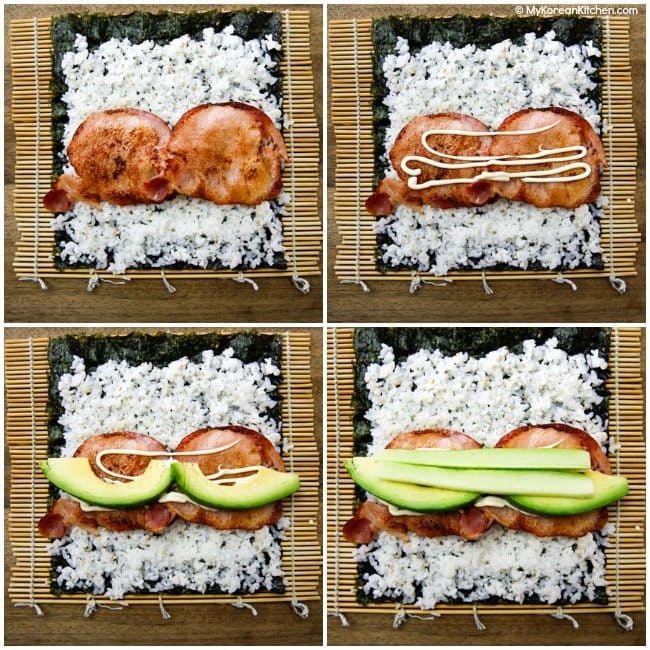
4. Once all the ingredients are set, lift the bottom end of the sushi mat to cover the ingredients. Once you cover them, roll up the seaweed to the top. (Paste some water or put some rice pieces at the edge of the seaweed sheet, if it doesn’t stick) Roll the sushi roll with the bamboo mat once more to give a firm shape. Repeat this process with the remaining ingredients.
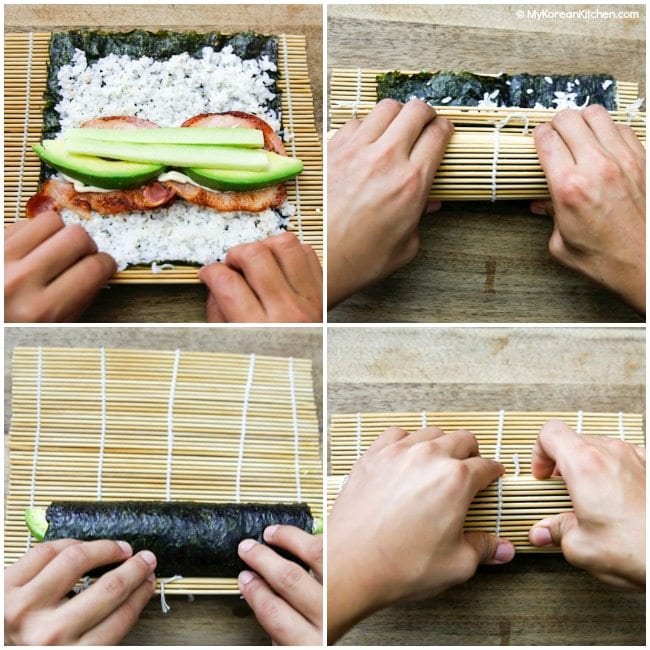
5. (Optionally brush the sesame oil on the outer layer of seaweed.) Cut the sushi roll into bite-size pieces. Alternatively, halve the roll and eat like a burrito. Serve with a dab of wasabi sauce and a dash of soy sauce.
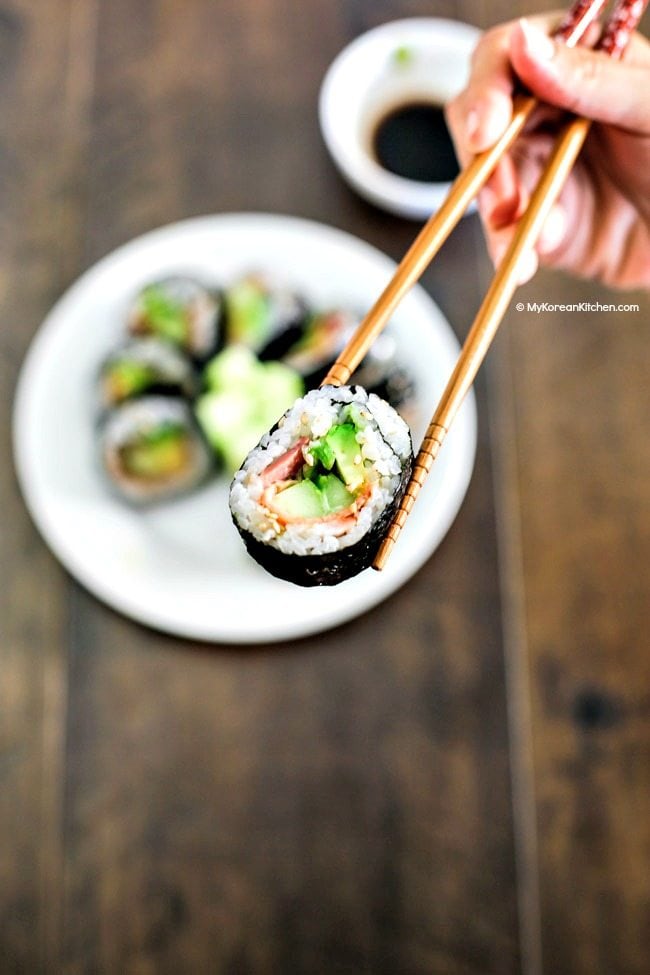
Note
- For general guidance on cooking Korean steamed rice (short grain rice), check my “How to cook perfect Korean steamed rice” post. For my rice, I used the “sushi rice setting” from my rice cooker. Sushi rice is slightly drier than typical Korean steamed rice.
- If you like sushi rolls, you might also like my other Korean rice roll recipes.
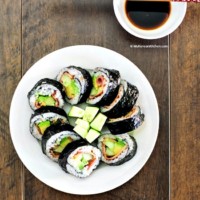
Bacon Avocado Cucumber Sushi Rolls
Ingredients
Main
- 5 1/2 cup steamed short grain rice (short grain rice)
- 1 Tbsp toasted sesame seeds
- 7 dried seaweed sheets
- 14 rindless short cut bacon rashers , cooked until well done (not too crispy)
- mayonnaise , I used Japanese Kewpie mayonnaise
- 1 avocado pitted, peeled and sliced, I used hass avocado
- 1 cucumber peeled and sliced into thin strips, I used English cucumber
- 1 Tbsp sesame oil (optional) to give some Korean flavour and/or to give a shiny look to the rolls
Sushi seasoning (Mix these in a small bowl and microwave it for about 30 seconds to dissolve the sugar. Alternatively you could use 3 Tbsp of pre-made sushi seasoning sauce)
- 3 Tbsp rice vinegar
- 2 Tbsp white sugar
- 1 tsp fine sea salt
Serve with
- A dab of wasabi sauce
- A dash of soy sauce
Instructions
- In a large bowl, mix the cooked sushi rice with the sushi seasoning and roasted sesame seeds. Set aside while other ingredients are being prepared as mentioned in the ingredients section.
- Place one seaweed sheet on a bamboo (sushi) mat and thinly spread the rice on the seaweed sheet. (I covered about 90% of the sheet)
- Place the prepared ingredients on top of the rice (in the lower centre of the rice) in the order of bacon, mayonnaise (3 to 4 rows), avocado and cucumber strips. (I used 2 short cut bacon, 2 avocado strips and 2 cucumber strips per one sushi rolls).
- Once all the ingredients are set, lift the bottom end of the sushi mat to cover the ingredients. Once you cover them, roll up the seaweed to the top. (Paste some water or put some rice pieces at the edge of the seaweed sheet, if it doesn’t stick) Roll the sushi roll with the bamboo mat once more to give a firm shape. Repeat this process with the remaining ingredients.
- (Optionally brush the sesame oil on the outer layer of seaweed.) Cut the sushi roll into bite size pieces. Alternatively, halve the roll and eat like a burrito. Serve with a dab of wasabi sauce and a dash of soy sauce.
Notes
Nutrition Info (per serving)
The nutrition information shown is an estimate provided by an online nutrition calculator. It should not be considered a substitute for a professional nutritionist’s advice.

